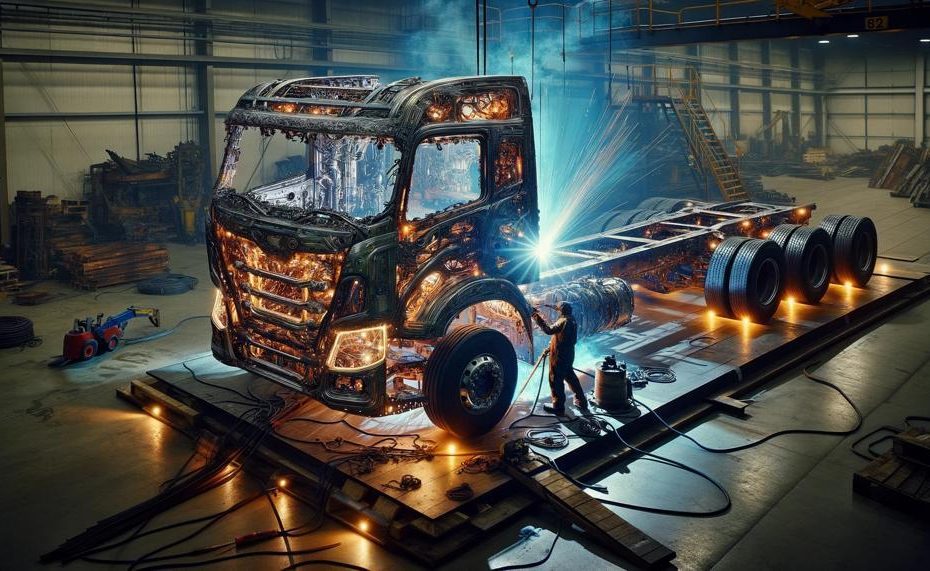Are you planning to upgrade your beloved vehicle? Before you get too carried away with flashy accessories and powerful engines, let’s talk about something that often gets overlooked – welding on the truck frame.
Sure, it may not be the most exciting topic, but trust us, it’s a crucial one. Whether you’re looking to add a lift kit for some off-roading adventures or need to reinforce your frame for heavy-duty towing, proper welding is essential.
So, is it ok to weld to a truck frame?
You should not weld a truck chassis. Welding can cause shrinkage stress and cracks. Some say that truck frames are heat treated for strength and should be modified using cold methods like bolts. However, others say that you can weld a cracked truck frame if you are an expert rated professional welder who understands heat treatment. They say that you should clean the rust and coatings off a much larger area than you think you need.
So sit tight and get ready to learn all about the art of welding on a truck frame.
Contents
Frame Welding Methods
When it comes to welding frames on trucks, there are several methods available, including Gas Metal Arc Welding (GMAW), Shielded Metal Arc Welding (SMAW), and Flux-Cored Arc Welding (FCAW).
These techniques are popular due to their versatility, affordability, and ease of use, making them suitable for welding frames of varying sizes and shapes. However, the choice of welding method can depend on factors such as the type of material being welded and the welder’s expertise.
Safety is of utmost importance when welding a truck frame, and it is crucial to follow guidelines set by the department of transportation in each state.
Problems With Frames
When it comes to welding truck frames, there are numerous potential issues that can arise, especially if proper precautions are not taken. Some of the most common problems include weak welds, decreased bending strength, and safety hazards. Let’s take a closer look at each of these concerns and how they can be prevented.
Weak Welds:
One of the primary concerns with welding truck frames is the risk of creating weak welds. This can occur due to inadequate training, improper welding techniques, or using subpar materials or equipment.
Weak welds can lead to structural failures and compromise the safety of the vehicle. To avoid this problem, it is crucial to follow proper welding techniques, use high-quality materials and equipment, and ensure that all welds are thoroughly inspected.
Decreased Bending Strength:
Welding can also affect the bending strength of a truck frame. The heat from welding can cause changes in the metal’s structure, making it more susceptible to cracks and corrosion. This can weaken the overall strength of the frame and compromise its ability to withstand stress and heavy loads.
To prevent this issue, it is important to carefully monitor temperature levels during welding and properly prepare the frame beforehand.
Safety Hazards:
Welding truck frames also poses potential safety hazards for both the welder and anyone using the vehicle. This is why it is crucial to adhere to state regulations and guidelines when welding a truck frame for commercial purposes. These guidelines help ensure that proper safety measures are in place and that the truck frame is structurally sound.
Bending
Bending is a complex process that involves the application of force to alter the shape of a material. In the context of truck frames, bending can occur due to a variety of factors, including accidents, heavy loads, and regular wear and tear. When a truck frame is bent, it can significantly impact its structural integrity, potentially creating safety hazards if not properly addressed.
Bending can weaken a truck frame in several ways. Firstly, it can create stress points on the frame, which can lead to cracks and fractures. These weak spots become even more vulnerable when welding is performed on a bent frame. Secondly, bending can change the properties of the metal, reducing its resistance to external forces. This can decrease the frame’s overall bending strength and performance.
Before deciding whether it is safe to weld on a bent truck frame, it is crucial to assess the severity of the bend and its impact on the frame’s overall structural integrity. Minor bends may not pose significant risks, but larger bends can greatly weaken the frame, making it unsafe to weld without proper repair.
In cases where welding is necessary on a bent truck frame, it is important to take extra precautions and ensure thorough preparation before beginning the welding process. This includes carefully aligning the frame, using high-quality materials and equipment, and adhering to state regulations for welding on vehicle frames.
Cracks
When it comes to identifying and assessing cracks on a truck frame, it is essential to have a trained and experienced individual carry out a comprehensive visual inspection. This should be followed by non-destructive testing methods, including ultrasonic testing, to pinpoint any internal damage that may not be immediately visible.
It is also important to take into account the precise location and severity of the cracks before determining if welding is a safe and appropriate method for repair.
In order to accurately identify and evaluate cracks on a truck frame, it is imperative to conduct a thorough visual inspection by a qualified and experienced professional. This should then be followed by non-destructive testing techniques, such as ultrasonic testing, to uncover any possible internal damage. Additionally, careful consideration must be given to the specific location and severity of the cracks in order to determine whether welding is a viable solution for repair.
To effectively detect and assess cracks on a truck frame, it is vital to carry out a meticulous visual inspection by a trained and experienced expert. This should be followed by non-destructive testing methods, such as ultrasonic testing, to identify any hidden damage.

Frame Welding Legal Issues
When it comes to welding truck frames, there are several legal issues that one must be aware of. These include non-compliance with state laws, safety concerns, negligence resulting in accidents or injuries, weakening of structural integrity during welding, and damages or failures due to incorrect techniques. To avoid these issues, it is crucial to take the necessary precautions and follow state-specific guidelines, regulations, and safety protocols.
One of the most important steps to prevent legal issues is to conduct thorough research on state laws and regulations regarding welding truck frames. Each state may have its own set of guidelines that must be followed to ensure compliance and avoid potential legal consequences.
Another key factor is to have certified welders perform any repairs or modifications. This not only ensures that the work is done correctly and safely but also eliminates the risk of negligence leading to accidents or injuries. In addition, using high-quality materials for welding is essential in maintaining the structural integrity of the frame and preventing any damages or failures.
Furthermore, it is crucial to comply with the Department of Transportation (DOT) and other governing bodies’ regulations for commercial vehicles when welding truck frames. These regulations are put in place to ensure the safety of both the vehicle and its occupants, making them essential to follow.
Proper preparation and technique are also crucial in preventing legal issues when welding truck frames. The surface must be properly prepared before beginning the welding process, and correct techniques for different types of metals must be used. It is also important to closely monitor temperature levels and reinforce any weak areas before welding to avoid weakening the frame’s structural integrity.
Finally, using incorrect welding techniques can lead to damages or failures in the future, resulting in potential legal issues. Therefore, it is crucial to use the correct techniques for different metals and consult a qualified professional for guidance if needed.
Frame Welding Procedure
When performing a frame welding procedure on a truck, it’s essential to take several precautionary measures to ensure the safety and structural integrity of the vehicle.
These steps include maintaining a clean workspace, donning proper protective gear, using functional welding equipment, working in a well-ventilated area, avoiding extreme weather conditions, and taking extra precautions in hazardous environments.
| Keep your workspace clean | Welding produces sparks and debris that can cause fires or injuries if not managed correctly. Before starting any welding work on a truck frame, it’s crucial to clear the area of any flammable materials or clutter that could pose a hazard. |
| Wear protective gear | To protect yourself from the intense heat, bright light, and harmful fumes produced by welding, it’s essential to wear suitable protective gear. This includes a welding helmet with a darkened visor, gloves, long-sleeved clothing, and closed-toe shoes. |
| Maintain functional welding equipment | Avoid accidents and injuries by ensuring your welding equipment is in good working condition before beginning any work on a truck frame. Make sure all safety features are functioning correctly. |
| Work in a well-ventilated area | The toxic fumes produced during welding can be harmful if inhaled. Always work in a well-ventilated area to prevent exposure to these fumes. If working indoors, make sure there is proper ventilation or use an exhaust system to remove fumes. |
| Avoid extreme weather conditions | Extreme weather conditions like high winds or rain can disrupt the welding process and lead to accidents. To ensure the job is done safely and efficiently, it’s best to avoid welding truck frames in these conditions. |
| Study the metals you’re welding | Having a good understanding of the metals you’re welding is crucial to ensuring proper techniques and precautions are taken. Different metals have different melting points, which can affect the welding process and the necessary safety precautions. |
| Take extra precautions in hazardous environments | In hazardous environments, such as on a busy road or near flammable materials, additional safety precautions should be taken when welding truck frames. These can include having a spotter to watch for potential hazards, using fire-resistant barriers, or utilizing a welding curtain to contain sparks. |
By following these safety measures when performing frame welding on a truck, you can ensure the job is done safely and effectively.
Truck Frame Welding
When working on a truck frame, welding can pose numerous risks to both the welder and the structural integrity of the truck. These risks include exposure to high temperatures, flames, sparks, radiation, fumes, gases, and chemicals. To safeguard against these dangers, proper precautions must be taken to minimize the potential risks.
Safety Precautions:
- Qualified Personnel: It is essential that only qualified and authorized personnel perform welding on a truck frame. This ensures that the welding is done correctly and safely.
- Proper Training: Employees must receive thorough training on safety procedures and the use of protective gear before undertaking any welding task. This includes understanding the risks associated with welding and how to minimize them.
- Use of Protective Gear: Welders must wear appropriate protective gear such as helmets, gloves, aprons, and boots while working on a truck frame. This protects them from exposure to high temperatures, flames, sparks, and UV radiation.
- Graded Approach: For higher risk joints on a truck frame, a graded approach should be used. This involves assessing the consequences of failure for each joint and taking extra precautions accordingly.
- Eye Protection: Proper eye protection is crucial when welding on a truck frame. Welders must use a filter lens to protect their eyes from UV radiation. It is recommended to start with a darker shade and gradually adjust to lighter shades for optimal visibility.
- Ventilation: Adequate ventilation in the work area is vital to minimize exposure to fumes and gases produced during the welding process. This is especially important in enclosed or poorly ventilated spaces.
By adhering to these safety precautions, potential risks associated with welding on a truck frame can be significantly reduced.
Bike Frame Welding
Bike Frame Welding can be a hazardous task, requiring extensive precautions to ensure safety and avoid potential risks. When it comes to welding on a truck frame, there are several main concerns that need to be addressed, including lack of penetration, lack of control, weight increase, and the possibility of compromising the vehicle’s integrity. However, by following certain guidelines and safety protocols, these risks can be mitigated.
- Lack of Penetration: The most significant concern when welding to a truck frame is the lack of penetration in the weld, which can result in a weak and unsafe joint. This risk can be minimized by ensuring that the welder has the necessary skills and training to achieve full penetration.
- Lack of Control: Precision and control are crucial when welding on a truck frame, which can be challenging for many welders. To mitigate this risk, it is imperative to have qualified personnel with sufficient experience and training in welding to truck frames.
- Weight Increase: Welding on a truck frame can significantly increase the vehicle’s weight, leading to reduced fuel efficiency. To address this concern, it is essential to use proper welding techniques and materials that minimize excess weight.
- Compromised Vehicle Integrity: Welding on a frame, repairing a damaged frame, or making modifications to the frame can potentially compromise the vehicle’s integrity. To avoid this risk, it is crucial to follow proper procedures and guidelines for welding on truck frames and regularly inspect the frame for any signs of weakness or damage.
- Cutting and Welding Techniques: Improper cutting and welding techniques can also weaken a truck frame. To mitigate this risk, it is essential to use appropriate cutting equipment and techniques when preparing the frame for welding and follow proper welding procedures to ensure strong and secure welds.
By being aware of these potential risks and taking necessary precautions, welding on a truck frame can be done safely and effectively. It is vital to have qualified personnel with proper training, use appropriate welding techniques and materials, and regularly inspect the frame for any signs of weakness.
Technicalities of Frame Welding
When it comes to welding on a truck frame, there are serious consequences that can arise if not done correctly. These consequences include safety risks, weakened frame strength, and reduced fuel efficiency. However, by following proper procedures and techniques, these consequences can be avoided.
Safety hazards from lack of penetration
One potential consequence of welding on a truck frame is insufficient penetration. This means that the weld does not fully penetrate through the metal, resulting in a weak joint that can fail under stress. This poses a significant safety risk as it compromises the structural integrity of the vehicle.
To prevent this, it is crucial to use proper welding techniques and equipment. This includes ensuring appropriate welding current and electrode size, as well as utilizing the right welding process for the type and thickness of metal being welded.
Lack of precision and control
Another consequence of improper welding on a truck frame is lack of control. Welding requires precise control to ensure proper heat distribution and penetration. Without this control, welds can be inconsistent and weak, leading to safety risks and compromised vehicle integrity.
To avoid this, it is essential for welders to have proper training and experience in welding techniques. This includes understanding how different metals react under heat and knowing how to adjust welding techniques accordingly.
Weight gain and reduced fuel efficiency
Welding on a truck frame can also result in weight gain, which can negatively impact the vehicle’s fuel efficiency. This is because adding extra metal through welding increases the overall weight of the vehicle, making it harder for the engine to move.
To prevent this, it is crucial to use proper welding techniques that minimize excess metal and ensure strong, efficient welds without adding unnecessary weight to the truck frame.
Compromised structural integrity
Finally, welding on a truck frame can compromise the overall integrity of the vehicle if not done correctly. This includes situations such as repairing a damaged frame, making modifications, or cutting and welding the frame vertically.
These actions can weaken the frame and make it more vulnerable to damage in the event of a collision.
Conclusion
In conclusion, while welding on a truck frame may not be the most thrilling topic, it is a crucial one for truck enthusiasts and DIYers alike. Understanding the various methods available and their significance in maintaining the structural integrity of your vehicle is essential.
To ensure a successful weld, proper preparation, adherence to safety guidelines, and using high-quality materials and equipment are paramount. Neglecting these steps can lead to weak welds, decreased bending strength, and even safety hazards.
When considering welding on a truck frame, factors such as bending, cracks, and legal implications must also be taken into account. It’s important to thoroughly assess the severity of any bends or cracks before deciding if welding is a safe solution. Moreover, following state regulations for commercial vehicles and taking necessary precautions during the welding process can help avoid any legal issues.
When performing a frame welding procedure on your truck, maintaining a clean workspace, wearing appropriate protective gear, using functional equipment, working in a well-ventilated area, and avoiding extreme weather conditions are all crucial steps.
By following these measures and being extra cautious in hazardous environments, you can ensure a safe and successful weld on your beloved vehicle.





